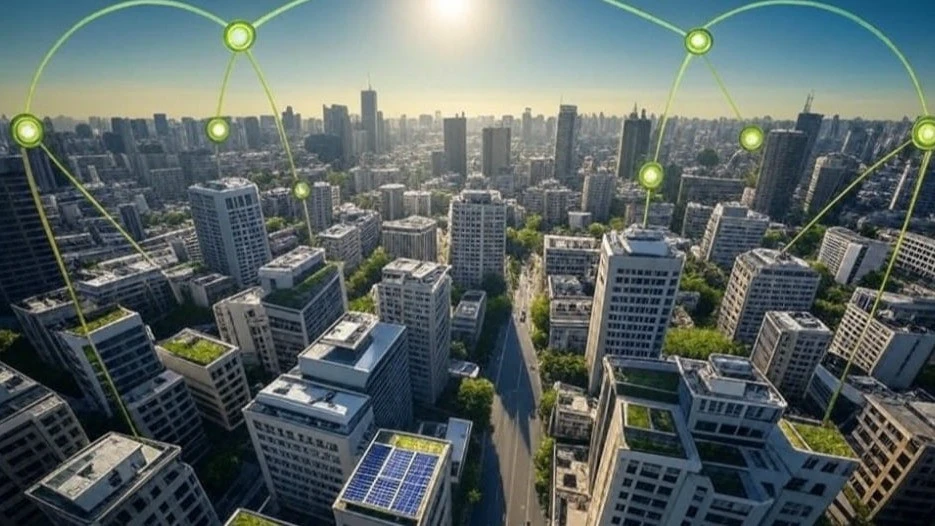
This website uses cookies
We use Cookies to ensure better performance, recognize your repeat visits and preferences, as well as to measure the effectiveness of campaigns and analyze traffic. For these reasons, we may share your site usage data with our analytics partners. Please, view our Cookie Policy to learn more about Cookies. By clicking «Allow all cookies», you consent to the use of ALL Cookies unless you disable them at any time.
Next-Gen Blockchain: How the Technology is Going Green
Just a decade ago, blockchain was synonymous with power-hungry mining farms consuming megawatts of energy. Today, the industry is undergoing a quiet revolution, transitioning toward eco-friendly solutions that preserve the benefits of decentralization.
The Consensus Evolution: From Carbon-Intensive to Green Algorithms
The cryptocurrency community has made significant strides in embracing environmental responsibility. Bitcoin, the industry pioneer with its Proof-of-Work mechanism, revealed an unexpected side effect - energy consumption comparable to entire countries. This very challenge became the catalyst for developing alternatives:
Proof-of-Stake (PoS) - A revolutionary approach where network security is maintained through economic incentives rather than computational power. Ethereum's transition to PoS (The Merge) reduced its energy consumption exponentially, proving the model's viability.
Hybrid Solutions - Such as Proof-of-History (Solana) or Delegated PoS (EOS), combining the best of different approaches.
Radical Innovations - Like Proof-of-Space (Chia), which uses disk storage instead of computations.
Preserving Decentralization: Myth or Reality?
The key question troubling the community: are we sacrificing fundamental principles for sustainability? Real-world implementations show modern algorithms successfully address this dilemma:
PoS networks (Cardano, Tezos) demonstrate attack resistance comparable to PoW
Random validator selection prevents centralization
Slot systems and rotation ensure equal participant opportunities
Proven Implementations:
Algorand - The first carbon-negative blockchain platform, offsetting 100% of emissions
Hedera Hashgraph - Energy-efficient consensus for enterprise solutions
Polygon - An eco-friendly L2 protocol with ambitious carbon neutrality plans
These examples prove that future blockchain technology isn't just compatible with sustainable development principles - it can become a driver of the digital economy's green transformation. The technological evolution continues, and the coming years promise even more radical improvements in distributed systems' energy efficiency.
Innovative Consensus Algorithms: From Energy Efficiency to Technological Breakthroughs
Proof-of-Stake (PoS) - The New Standard of Sustainability
The Proof-of-Stake mechanism has revolutionized the blockchain industry by introducing a fundamentally new approach to network security. Unlike energy-intensive PoW, where miners compete in computational power, PoS utilizes economic incentives:
• 99.9% reduced energy consumption compared to Bitcoin • Instant transaction finality (2-3 seconds vs BTC's 10+ minutes) • Built-in mechanisms preventing centralization (validator rotation, slashing)
Industry leaders:
Ethereum 2.0 - the flagship transition to PoS
Cardano with its scientifically-proven Ouroboros algorithm
Polkadot and its nominated validator system
Hybrid Models: Technological Symbiosis
Modern blockchains increasingly combine different approaches:
PoS + PoW (Decred, Horizen)
DPoS + BFT (EOS, Tron)
PoH + PoS (Solana)
Tomorrow's Algorithms
Proof-of-Space-Time (Chia, Filecoin)
Proof-of-Participation (next-gen PoS)
Quantum-Resistant Algorithms
AI-Optimized Consensus
Expert Predictions: By 2025, 85% of new blockchain projects will feature:
Hybrid consensus models
Built-in carbon neutrality mechanisms
Automated energy management systems
These innovations don't just solve energy consumption issues - they pave the way for mass blockchain adoption in regulated industries and IoT ecosystems. The next generation of consensus protocols will likely integrate with emerging technologies like AI and quantum computing while maintaining rigorous security standards and true decentralization principles.
Leaders of the Green Blockchain Movement: How the Crypto Industry is Changing the Eco-Paradigm
1. Pioneering Platforms of Eco-Friendly Solutions
The modern blockchain landscape showcases impressive examples of transitioning to green technologies:
Ethereum made history by switching to PoS (Proof-of-Stake) in 2022, reducing energy consumption by 99.95%. Known as "The Merge," this transition became a turning point for the entire industry, proving that scalability is possible without environmental compromises.
Algorand developed a unique Pure Proof-of-Stake mechanism that not only minimizes energy costs but also implements a carbon negativity program. The platform automatically offsets CO2 emissions through its partnership with ClimateTrade.
Tezos utilizes innovative Liquid Proof-of-Stake with dynamic validator participation. Its energy efficiency is confirmed through partnerships with major corporations like McLaren and Ubisoft for eco-friendly NFT projects.
2. Corporate Blockchain Solutions with Zero Footprint
Major businesses are actively adopting sustainable distributed ledgers:
IBM Food Trust, built on Hyperledger Fabric, helps retail giants track sustainable supply chains. The system consumes orders of magnitude less energy than public blockchains while preserving all the technology's benefits.
VeChain with its Proof-of-Authority consensus, has become the standard for eco-friendly corporate blockchain. Projects with BMW and Walmart China demonstrate how to reduce carbon footprints across entire supply chains.
Hedera Hashgraph offers an alternative ABFT approach used by Google and Boeing for ESG initiatives. Their energy consumption per transaction is comparable to regular online payments.
3. Renewable Energy in Blockchain Infrastructure
Innovative energy initiatives:
• Solar mining: Tesla and Block invest in solar farms to power Bitcoin nodes • Geothermal solutions: El Salvador utilizes volcanic energy for mining • Wind-powered validators: Cardano develops a clean-energy node network • Carbon credits: Polygon and KlimaDAO create DeFi tools for emission offsets
Expert Future Outlook
Analysts highlight three key trends:
Growth of "green" staking pools with mandatory ESG certification
Development of carbon audit standards for blockchain protocols
Integration of IoT and blockchain for real-time eco-monitoring
These initiatives demonstrate that the blockchain industry isn't just adapting to environmental requirements, but is becoming a driver of sustainable technological change on a global scale. The convergence of distributed ledger technology with renewable energy solutions creates new paradigms for ecological responsibility in the digital age, setting benchmarks for other tech sectors to follow.
Blockchain for Sustainable Development: Next-Generation Technologies
1. Transforming Green Energy
Blockchain solutions are revolutionizing renewable energy management by offering:
Decentralized Energy Markets Platforms like Power Ledger and WePower enable households with solar panels to sell excess energy to neighbors through automated smart contracts. Similar systems in Germany have already reduced energy transmission losses by 15%.
Energy Origin Certification Energy Web Chain creates digital certificates verifying the "clean" source of each kWh. Major players (Shell, Total) use this system for ESG reporting.
Urban Grid Optimization In Brooklyn, the LO3 Energy project is testing microgrids where blockchain balances supply and demand in real time, reducing peak loads.
2. Tokenization of Environmental Assets
Blockchain solves key problems of traditional eco-markets:
Carbon Credits 2.0
KlimaDAO and Toucan Protocol have digitized VERRA/Gold Standard credits
Each token represents 1 ton of CO2 with full reduction history
New Asset Classes
NFT certificates for forest conservation (Moss.Earth)
Tokenized protected land hectares
Digital REC certificates for businesses
Example: Airbus uses blockchain credits to offset emissions from aircraft production.
3. Intelligent Environmental Monitoring
Technology combinations create transparent control systems:
Innovative Solutions:
Satellite Tracking
Sensor Networks
Automated Reporting
Key Advantages:
Tamper-proof data recording
Reduced bureaucracy in eco-control
New opportunities for citizen science
Outlook: By 2025, 40% of ESG data will be stored in blockchain registries (Gartner).
This approach doesn't just optimize processes - it creates an entirely new model of environmental governance where technology serves planetary conservation.
The integration of distributed ledger technology with IoT devices and satellite monitoring establishes unprecedented transparency in ecological accounting, while tokenization mechanisms create liquid markets for sustainability assets. These innovations demonstrate how blockchain is evolving from a financial instrument to a foundational technology for achieving the UN Sustainable Development Goals.
The Future of Green Blockchain: Harmonizing Technology and Nature
Integration with Smart Energy Grids
Modern energy systems are gradually transforming thanks to blockchain technology. In the coming years, we can expect to see intelligent energy markets where smart contracts will automatically redistribute excess energy between network participants. For example, the Energy Web project is already developing such solutions.
Key benefits of this integration include:
Real-time energy consumption optimization
Reduced energy transmission losses
Incentivizing renewable energy usage
Environmental Certification Standards
The development of "green" blockchain requires clear rules and standards. Experts predict that by 2025 we will see:
Unified requirements for blockchain project energy efficiency
A node certification system based on environmental criteria
Transparent carbon footprint reporting for all market participants
These measures will help create a fair, competitive environment and accelerate the transition to eco-friendly technologies.
Promising Development Directions
Analysts highlight several promising trends:
Technological Innovations
Hybrid consensus algorithms combining different approaches' advantages
AI applications for energy consumption optimization
Quantum-resistant solutions for long-term security
Practical Applications
Secondary resource and waste tracking systems
Decentralized environmental initiatives (DAOs)
IoT integration for environmental monitoring
A current example of successful implementation is the Helium network, which combines blockchain with energy-efficient IoT solutions. This project demonstrates how modern technologies can benefit ecology.
The future of blockchain isn't just about reducing energy consumption, but about creating a holistic system where technological progress goes hand in hand with environmental care. As standards develop and new solutions are implemented, we'll witness how the crypto industry transforms from being part of the problem to becoming part of the solution.
Building a Sustainable Blockchain Future: A Practical Guide
As blockchain technology evolves toward greater sustainability, individuals and organizations have multiple pathways to participate in this transformation. Here's how you can engage with eco-friendly blockchain solutions across different roles.
Selecting Environmentally Conscious Blockchain Platforms
When evaluating blockchain networks for sustainability, consider these key factors:
Consensus Mechanisms Prioritize energy-efficient protocols like Proof-of-Stake (PoS) or Delegated PoS (DPoS) over traditional Proof-of-Work systems. Emerging alternatives such as Proof-of-Space and Proof-of-History also offer promising energy savings.
Energy Consumption Metrics: Compare networks based on their energy use per transaction. For instance, post-Merge Ethereum operates at about 0.01 kWh per transaction, while traditional PoW systems consume significantly more.
Sustainability Commitments Look for platforms with verifiable environmental policies, such as Algorand's carbon-negative status or Polygon's carbon neutrality initiatives. Certifications from organizations like the Crypto Climate Accord add credibility.
Leading sustainable blockchain options include:
Ethereum (transitioned to PoS)
Algorand (carbon-negative architecture)
Tezos (self-upgrading, energy-efficient network)
Opportunities Across the Ecosystem
For Developers: The shift toward green blockchain creates numerous technical opportunities. Developers can build decentralized applications on low-energy platforms like Ethereum Layer 2 solutions or Algorand. The growing market for sustainable digital assets presents chances to create eco-friendly NFT projects or develop tools for carbon credit tracking.
For Investors, Sustainable investment options are expanding in the blockchain space. Investors can support PoS networks through staking, participate in carbon credit markets like KlimaDAO, or explore green crypto investment funds. The tokenization of environmental assets offers new avenues for impact investing.
Emerging Frontiers in Sustainable Blockchain
Research and development in green blockchain technology is advancing across several key areas:
Energy Optimization Projects are exploring AI-driven approaches to reduce computational waste and improve network efficiency. Some initiatives are testing renewable-powered validation systems.
Environmental Applications: Practical implementations include:
Governance Innovations: New models like decentralized autonomous organizations (DAOs) are being applied to environmental funding and decision-making.
Taking Action
Getting involved in sustainable blockchain can start with simple steps:
Transition personal crypto holdings to PoS-based assets
Support blockchain projects with verifiable environmental benefits
Contribute to open-source initiatives focused on green solutions
The convergence of blockchain technology and environmental sustainability represents one of the most promising developments in the digital asset space. By making informed choices and participating in eco-conscious projects, individuals and organizations can help shape a more sustainable future for blockchain technology while potentially benefiting from its growth.
Conclusion: Blockchain - Future Technologies Available Today
Blockchain continues to transform the digital landscape, offering solutions for business, finance, and data management. As experts with deep technical expertise, we are ready to help you implement any project, from creating your own blockchain network to integrating decentralized technologies into existing systems.
Why choose us?
Expertise in all key areas:
Smart contract development (Solidity, Rust, Move)
Creation of private and public blockchain networks
Performance and security optimization
Results-driven approach:
Business needs analysis and optimal solution selection
Flexible collaboration models (from consulting to full-cycle development)
Support at all stages - from idea to scaling
Technologies we work with:
Ethereum, Hyperledger, Cosmos, Polkadot, and other platforms
Web3, DeFi, NFT, DAO, and other innovative concepts
Ready to get started? No matter the scale or complexity of your project, we will bring it to life using the most advanced blockchain technologies. Blockchain isn't just technology - it's new opportunities. Let's make them happen together!




